A Study on Combustion Characteristics of Insensitive Triple-Base Propellant
Abstract
:1. Introduction
2. Materials and Methods
3. Results and Discussion
3.1. Self-Illuminating Properties of the Combustion Flame
3.2. NO and NH Chemiluminescence Characteristics
3.3. OH-PLIF Signal of Propellants
4. Conclusions
Author Contributions
Funding
Data Availability Statement
Conflicts of Interest
References
- Sanghavi, R.R.; Khire, V.H.; Chakraborthy, T.K.; Singh, A. Studies on RDX influence on performance increase of triple base propellants. Propellants Explos. Pyrotech. 2006, 31, 318–321. [Google Scholar] [CrossRef]
- Lawton, B. Thermo-chemical erosion in gun barrels. Wear 2001, 251, 827–838. [Google Scholar] [CrossRef]
- Elbasuney, S.; Yehia, M.; Ismael, S.; El Gamal, M. Novel ammonium perchlorate/RDX co-crystal: Bespoke energetic materials with tailored decomposition kinetics. J. Energetic Mater. 2023. [Google Scholar] [CrossRef]
- Wu, N.; Lu, Z.; Jin, S.; Zhang, Z.; Wang, J.; Gao, J. Preparation of NTO/HMX based PBX by water slurry method. Mod. Chem. Ind. 2016, 36, 75–78. (In Chinese) [Google Scholar] [CrossRef]
- Yan, X.; Li, X.D.; Zhou, P.; Ji, W.; Shi, X.F. Preparation of Insensitive RDX by Suspension Spray Technology and Its Characterization. Cent. Eur. J. Energetic Mater. 2019, 16, 216–227. [Google Scholar] [CrossRef]
- Louden, J.D.; Kelly, J.; Phillipson, J. Methylcentralite Concentration Profiles in Monoperforated Extruded Nitrocellulose and Nitrocellulose Nitroglycerine Propellant Grains by Raman Microspectroscopy. J. Appl. Polym. Sci. 1989, 37, 3237–3250. [Google Scholar] [CrossRef]
- Yao, J.; Li, B.; Xie, L.F. Fabrication and properties of sphere CL-20/RDX composites with different molar ratios. J. Energetic Mater. 2022. [Google Scholar] [CrossRef]
- Hussein, A.K.; Elbeih, A.; Jungova, M.; Zeman, S. Explosive Properties of a High Explosive Composition Based on Cis-1,3,4,6-tetranitrooctahydroimidazo-4,5-d imidazole and 1,1-Diamino-2,2-dinitroethene (BCHMX/FOX-7). Propellants Explos. Pyrotech. 2018, 43, 472–478. [Google Scholar] [CrossRef]
- Gong, L.; Li, Y.H.; Guo, Y.P.; Li, J.M.; Yang, R.J. Effect of Morphology for Ammonium Dinitramide on the Mechanical and Combustion Properties of Composite Propargyl-terminated Copolyether Propellant. Propellants Explos. Pyrotech. 2020, 45, 864–870. [Google Scholar] [CrossRef]
- Yan, Q.L.; Zeman, S.; Elbeih, A. Recent advances in thermal analysis and stability evaluation of insensitive plastic bonded explosives (PBXs). Thermochim. Acta 2012, 537, 1–12. [Google Scholar] [CrossRef]
- Manhas, P.; Saini, R.; Singh, A.; Soni, P.; Sharma, R.K. Thermoplastic polyurethane-based nanoencapsulation strategy for efficient storage and stability of RDX. J. Mol. Liq. 2022, 348, 118076. [Google Scholar] [CrossRef]
- Chen, Y.; Zhang, M.; Li, H.; Qin, Z.; Zhao, F.Q.; Li, H.; Xu, K.Z. Effects of Sn-containing intermetallic compounds on the thermal decomposition and ignition properties of RDX and TKX-50. J. Alloys Compd. 2022, 926, 166831. [Google Scholar] [CrossRef]
- Liau, Y.-C.; Yang, V. Analysis of RDX Monopropellant Combustion with Two-Phase Subsurface Reactions. J. Propuls. Power 1995, 11, 729–739. [Google Scholar] [CrossRef]
- Cropek, D.M.; Kemme, P.A.; Day, J.M.; Cochran, J. Use of pyrolysis GC/MS for predicting emission byproducts from the incineration of double-base propellant. Environ. Sci. Technol. 2002, 36, 4346–4351. [Google Scholar] [CrossRef]
- Chen, L.; Nan, F.Q.; Li, Q.; Zhang, J.W.; Jin, G.R.; Wang, M.R.; Cao, X.; Liu, J.; He, W.D. Sol-gel synthesis of insensitive nitrated bacterial cellulose/cyclotrimethylenetrinitramine nano-energetic composites and its thermal decomposition property. Cellulose 2022, 29, 7331–7351. [Google Scholar] [CrossRef]
- Zhang, J.W.; Chen, L.; Zhao, L.Y.; Jin, G.R.; He, W.D. Experimental insight into interaction mechanism of 1H-tetrazole and nitrocellulose by kinetics methods and TG-DSC-FTIR analysis. J. Anal. Appl. Pyrolysis 2023, 169, 105853. [Google Scholar] [CrossRef]
- Kim, M.T.; Song, S.; Yim, Y.-J.; Jang, M.W.; Baek, G. Comparative Study on Infrared Irradiance Emitted from Standard and Real Rocket Motor Plumes. Propellants Explos. Pyrotech. 2015, 40, 779–785. [Google Scholar] [CrossRef]
- Parr, T.P.; Hanson-Parr, D.M. Solid propellant flame structure. In Proceedings of the Materials Research Society Symposium, San Francisco, CA, USA, 8–12 April 1996; pp. 207–219. [Google Scholar]
- Ruesch, M.D.; Powell, M.S.; Satija, A.; Ruesch, J.P.; Vuppuluri, V.S.; Lucht, R.P.; Son, S.F. Burning rate and flame structure of cocrystals of CL-20 and a polycrystalline composite crystal of HMX/AP. Combust. Flame 2020, 219, 129–135. [Google Scholar] [CrossRef]
- Fan, Q.; Liu, X.; Xu, L.; Subash, A.A.; Brackmann, C.; Alden, M.; Bai, X.-S.; Li, Z. Flame structure and burning velocity of ammonia/air turbulent premixed flames at high Karlovitz number conditions. Combust. Flame 2022, 238, 111943. [Google Scholar] [CrossRef]
- Cai, X.; Fan, Q.; Bai, X.-S.; Wang, J.; Zhang, M.; Huang, Z.; Alden, M.; Li, Z. Turbulent burning velocity and its related statistics of ammonia-hydrogen-air jet flames at high Karlovitz number: Effect of differential diffusion. Proc. Combust. Inst. 2022; in press. [Google Scholar] [CrossRef]
- Osvaldo Vigueras-Zuniga, M.; Elena Tejeda-del-Cueto, M.; Mashruk, S.; Kovaleva, M.; Leonardo Ordonez-Romero, C.; Valera-Medina, A. Methane/Ammonia Radical Formation during High Temperature Reactions in Swirl Burners. Energies 2021, 14, 6624. [Google Scholar] [CrossRef]
- Yang, D.; Zhao, B.; Fu, H. Regulation and Optimization of Multibase Propellant Burning Characteristics. Chin. J. Explos. Propellants 1997, 1, 31–34. (In Chinese) [Google Scholar]
- Harris, N.J.; Lammertsma, K. Ab initio density functional computations of conformations and bond dissociation energies for hexahydro-1,3,5-trinitro-1,3,5-triazine. J. Am. Chem. Soc. 1997, 119, 6583–6589. [Google Scholar] [CrossRef]
- Chen, L.; Wang, H.Q.; Wang, F.P.; Geng, D.S.; Wu, J.Y.; Lu, J.Y. Thermal Decomposition Mechanism of 2,2′,4,4′,6,6′-Hexanitrostilbene by ReaxFF Reactive Molecular Dynamics Simulations. J. Phys. Chem. C 2018, 122, 19309–19318. [Google Scholar] [CrossRef]
- Jun, Z.; Guie, L. Effect of ambient humidity on thermal decomposition of triple-base propellant. Sci. Technol. Eng. 2008, 19, 5509–5511. (In Chinese) [Google Scholar]
- Wang, Y.; Liu, R.; Ning, P.; Pan, Q.; Hu, R. Mechanism of thermal decomposition of nitrocotton. Chin. J. Energetic Mater. 1998, 6, 14–25. (In Chinese) [Google Scholar]
- Roh, T.S.; Tseng, I.S.; Yang, V. Effects of Acoustic-Oscillations on Flame Dynamics of Homogeneous Propellants in Rocket Motors. J. Propuls. Power 1995, 11, 640–650. [Google Scholar] [CrossRef]
- Volk, F. Determination of Gaseous and Solid Decomposition Products of Nitroguanidine. Propellants Explos. Pyrotech. 1985, 10, 139–146. [Google Scholar] [CrossRef]
- Miller, M.S.; Anderson, W.R. Energetic-Material Combustion Modeling with Elementary Gas-Phase Reactions: A Practical Approach. In Solid Propellant Chemistry, Combustion, and Motor Interior Ballistics; Progress in Astronautics and Aeronautics; American Institute of Aeronautics and Astronautics: Reston, WA, USA, 2000; pp. 501–531. [Google Scholar]
- Otomo, J.; Koshi, M.; Mitsumori, T.; Iwasaki, H.; Yamada, K. Chemical kinetic modeling of ammonia oxidation with improved reaction mechanism for ammonia/air and ammonia/hydrogen/air combustion. Int. J. Hydrogen Energy 2018, 43, 3004–3014. [Google Scholar] [CrossRef]
- Vanderhoff, J.A.; Teague, M.W.; Kotlar, A.J. Determination of temperature and no concentrations through the dark zone of solid-propellant flames. In Symposium (International) on Combustion; Elsevier: Amsterdam, The Netherlands, 1992. [Google Scholar]
- Yang, R.J.; Thakre, P.; Liau, Y.C.; Yang, V. Formation of dark zone and its temperature plateau in solid-propellant flames: A review. Combust. Flame 2006, 145, 38–58. [Google Scholar] [CrossRef]
- Yan, Z.; Wang, L.; Song, C.; Li, Q.; Niu, Y.; Wang, J.; Huang, Z. Optical Diagnosis of RDX Condensing Ignition and Reaction Process. Chin. J. Explos. Propellants 2021, 44, 468–473. (In Chinese) [Google Scholar]
- Yetter, R.A.; Dryer, F.L.; Allen, M.T.; Gatto, J.L. Development of Gas-Phase Reaction Mechanisms for Nitramine Combustion. J. Propuls. Power 1995, 11, 683–697. [Google Scholar] [CrossRef]
- Pugh, D.; Runyon, J.; Bowen, P.; Giles, A.; Valera-Medina, A.; Marsh, R.; Goktepe, B.; Hewlett, S. An investigation of ammonia primary flame combustor concepts for emissions reduction with OH*, NH2* and NH* chemiluminescence at elevated conditions. Proc. Combust. Inst. 2021, 38, 6451–6459. [Google Scholar] [CrossRef]
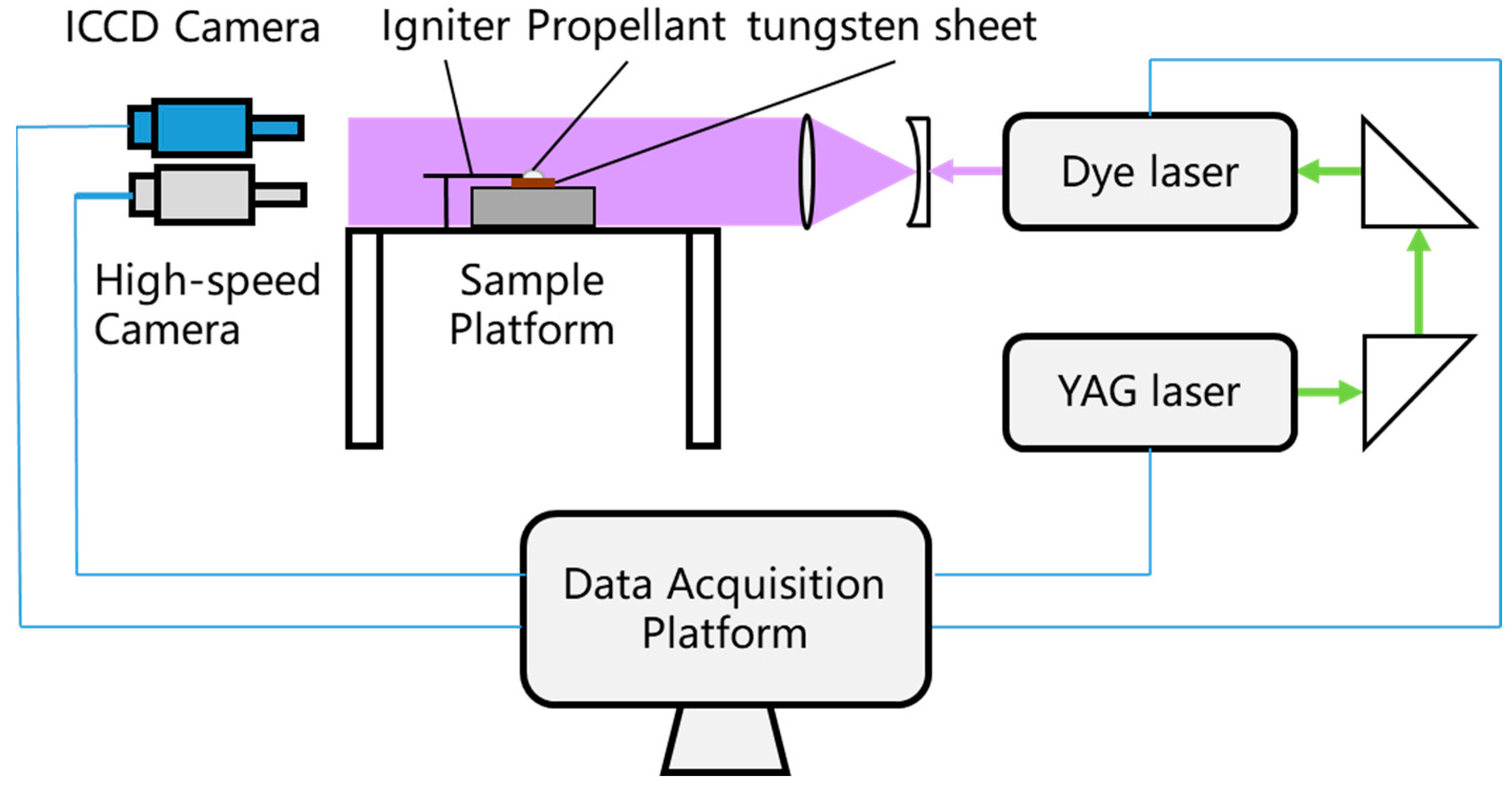

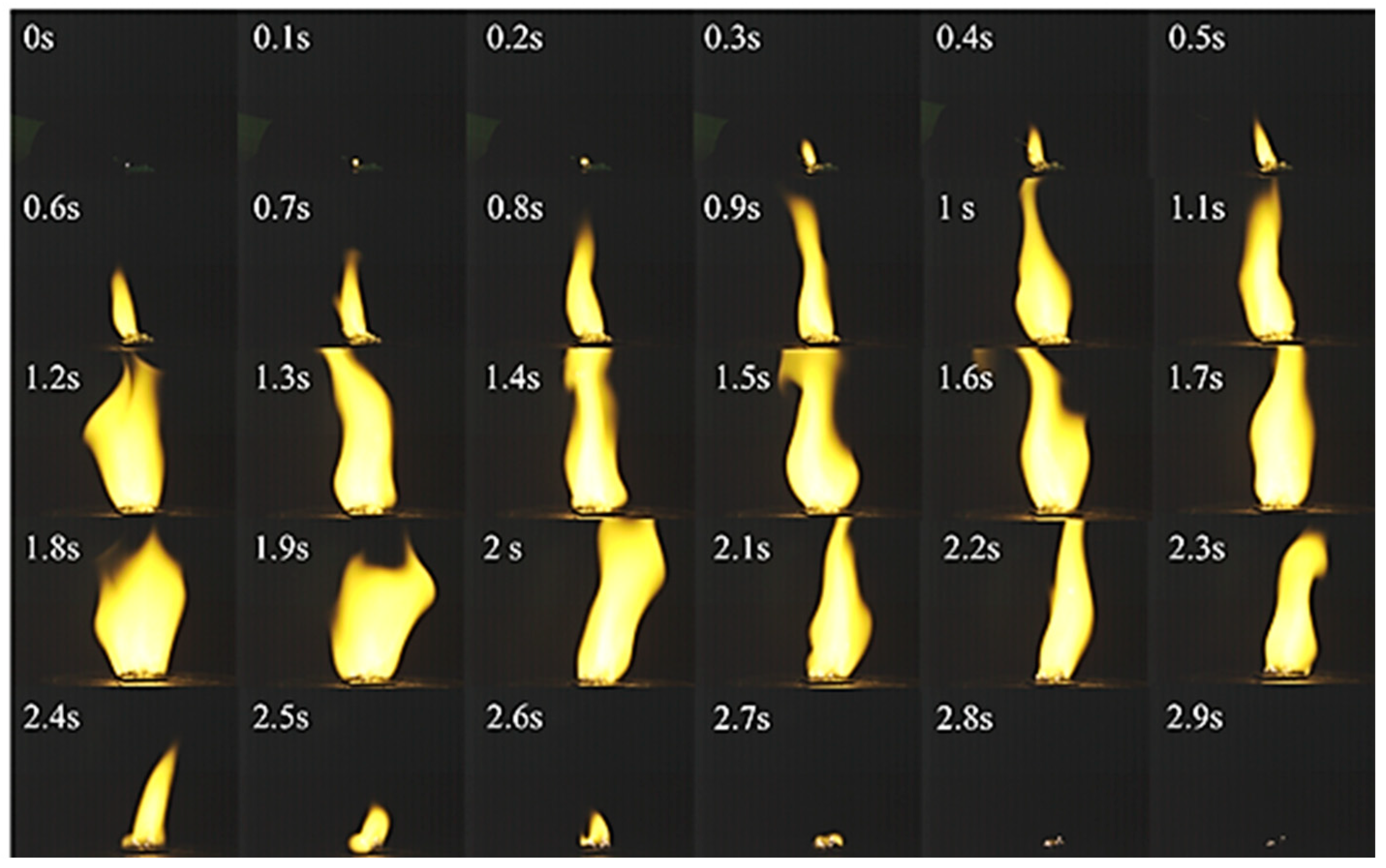
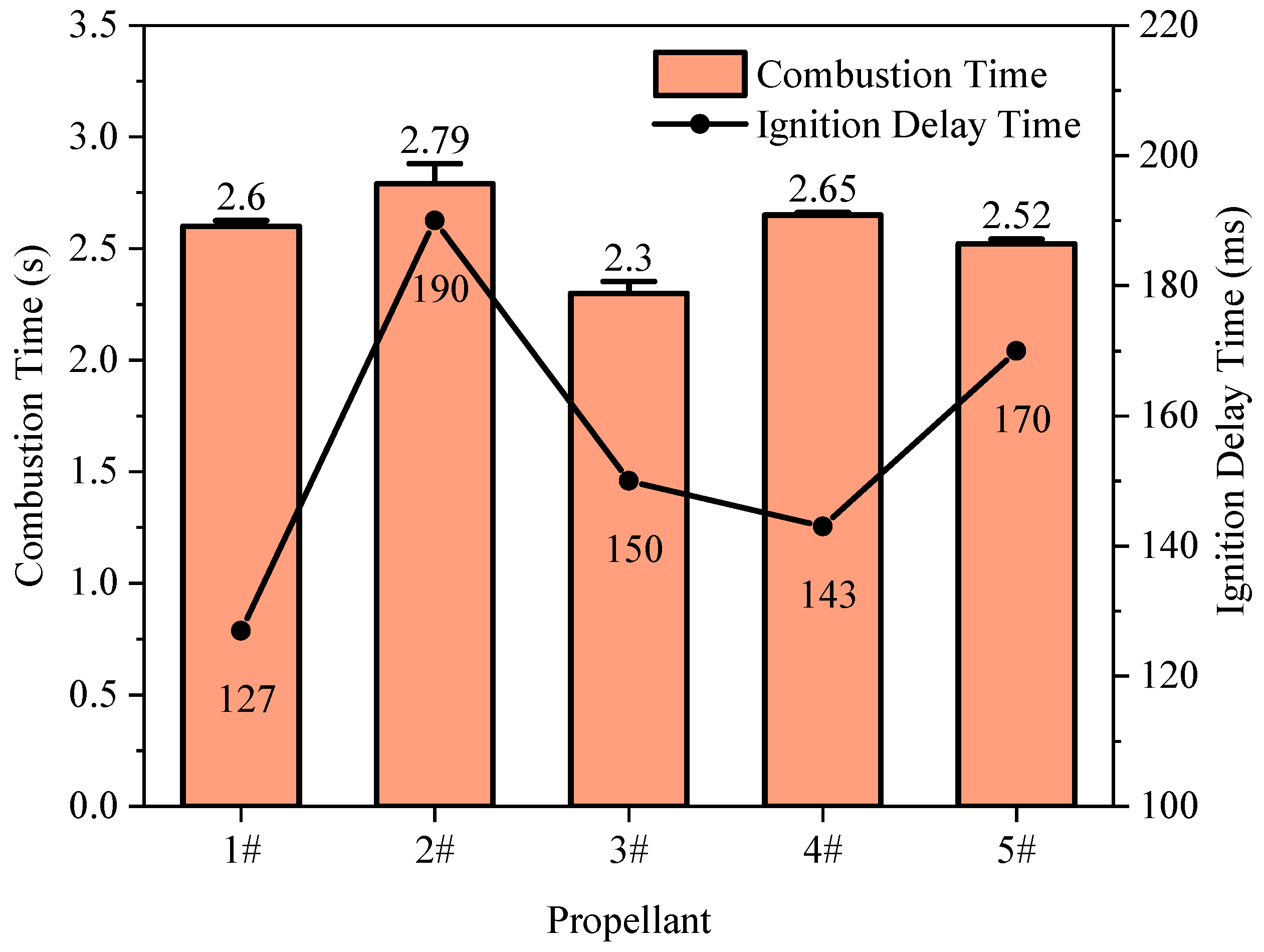


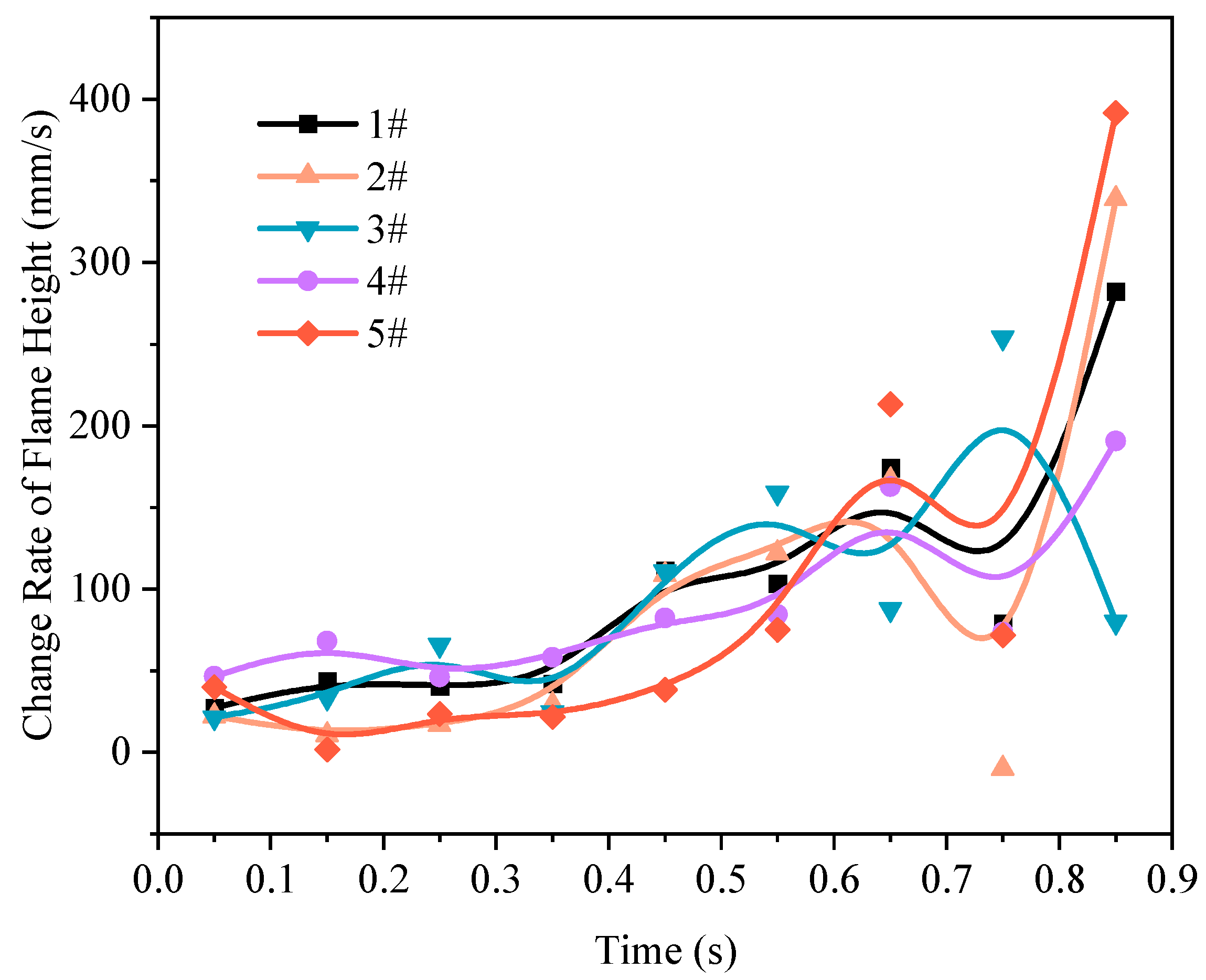

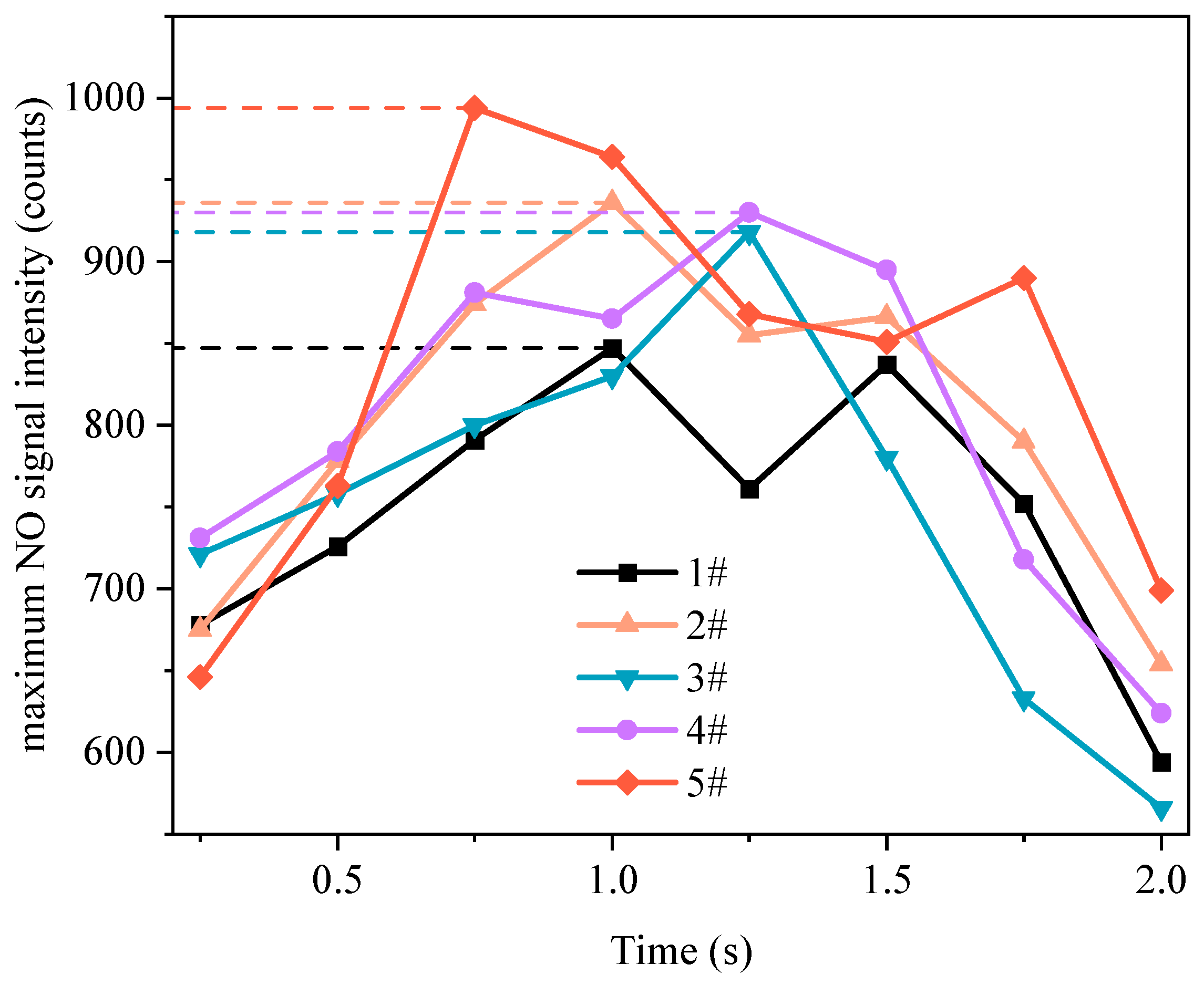
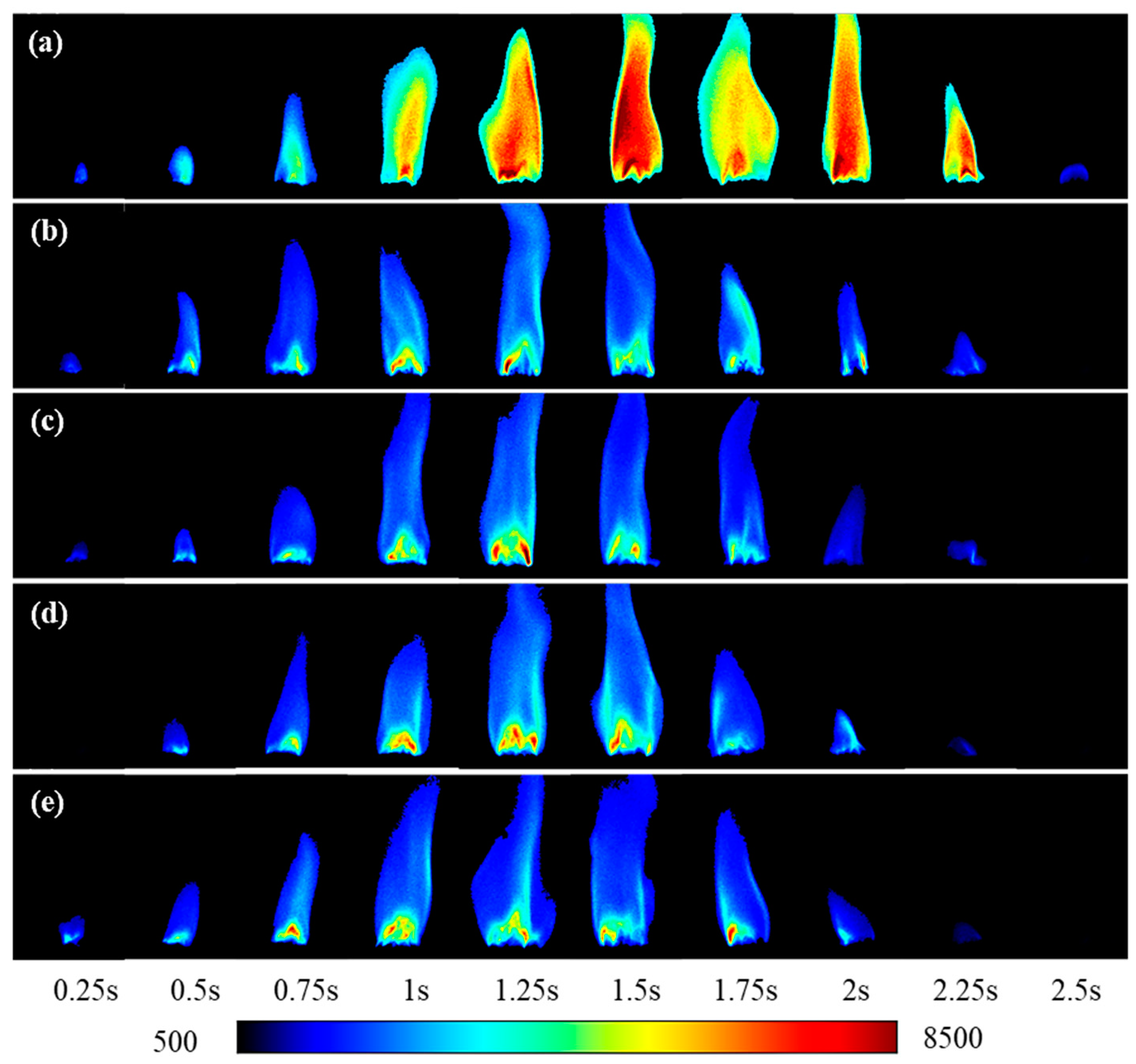


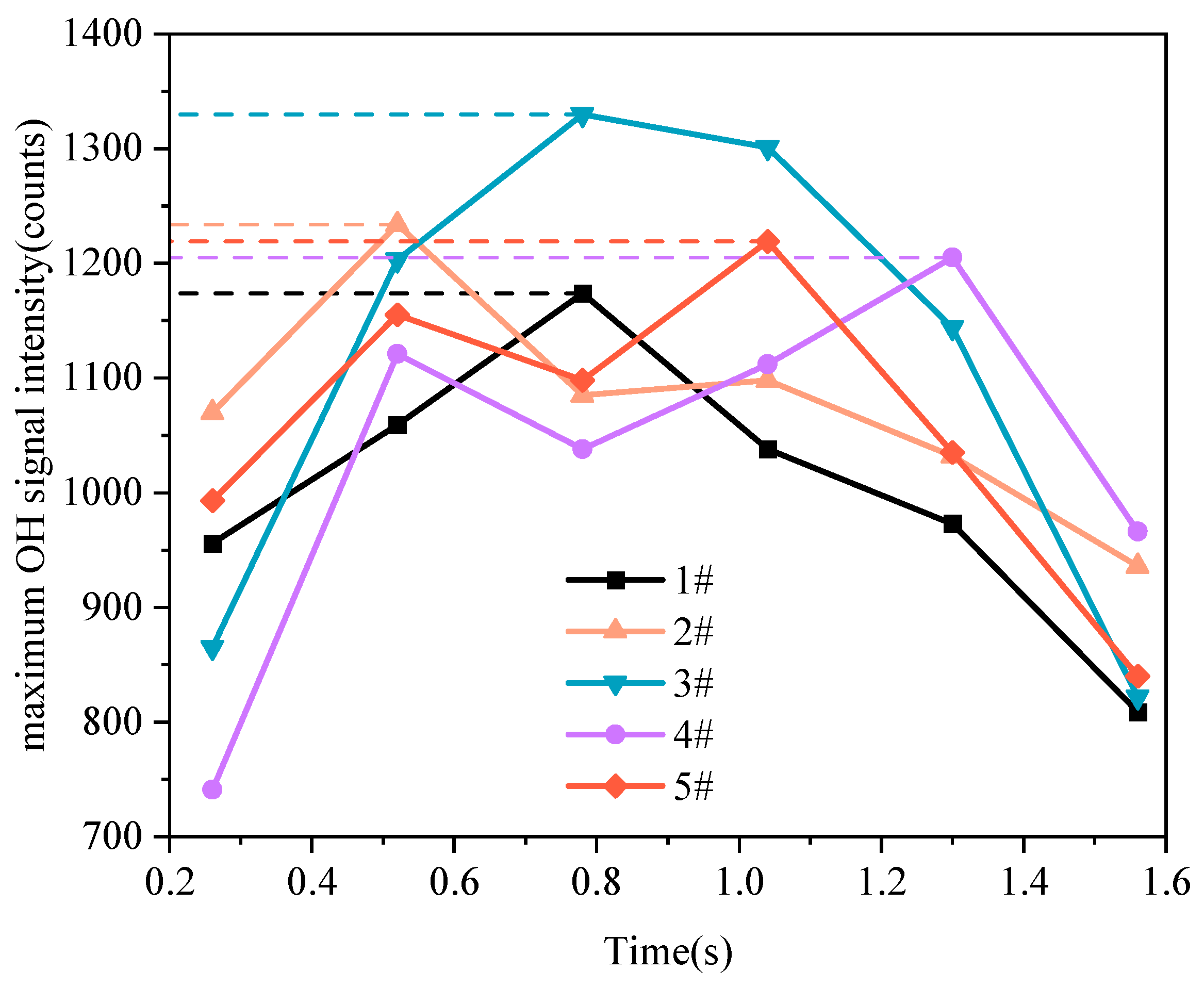
Disclaimer/Publisher’s Note: The statements, opinions and data contained in all publications are solely those of the individual author(s) and contributor(s) and not of MDPI and/or the editor(s). MDPI and/or the editor(s) disclaim responsibility for any injury to people or property resulting from any ideas, methods, instructions or products referred to in the content. |
© 2023 by the authors. Licensee MDPI, Basel, Switzerland. This article is an open access article distributed under the terms and conditions of the Creative Commons Attribution (CC BY) license (https://creativecommons.org/licenses/by/4.0/).
Share and Cite
Yang, Y.; Zhu, T.; Yan, Z.; Li, Q.; Liu, B.; Wang, J.; Huang, Z. A Study on Combustion Characteristics of Insensitive Triple-Base Propellant. Appl. Sci. 2023, 13, 5462. https://doi.org/10.3390/app13095462
Yang Y, Zhu T, Yan Z, Li Q, Liu B, Wang J, Huang Z. A Study on Combustion Characteristics of Insensitive Triple-Base Propellant. Applied Sciences. 2023; 13(9):5462. https://doi.org/10.3390/app13095462
Chicago/Turabian StyleYang, Yilan, Tianyi Zhu, Zhiyu Yan, Qianqian Li, Bo Liu, Jinhua Wang, and Zuohua Huang. 2023. "A Study on Combustion Characteristics of Insensitive Triple-Base Propellant" Applied Sciences 13, no. 9: 5462. https://doi.org/10.3390/app13095462






